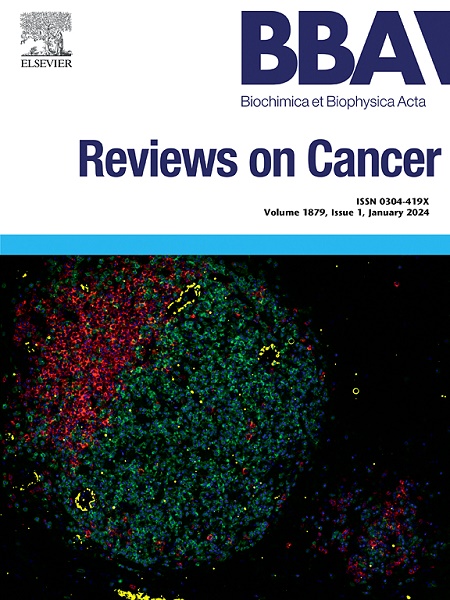Heparanase as a therapeutic target for mitigating cancer progression
IF 9.7
1区 医学
Q1 BIOCHEMISTRY & MOLECULAR BIOLOGY
Biochimica et biophysica acta. Reviews on cancer
Pub Date : 2025-09-08
DOI:10.1016/j.bbcan.2025.189441
引用次数: 0
Abstract
Cancer has been one of the primary causes of mortality for the last three decades across the globe, with contemporary treatment modalities often falling short due to limitations viz. drug resistance, toxicity, and the inability to target molecular mechanisms of tumor progression. Among various intracellular mediators implicated in cancer progression, heparanase, a heparan sulfate degrading enzyme, has been pivotal by facilitating tumor invasion, angiogenesis, and metastasis. Inhibiting the activity of heparanase is a promising therapeutic approach that can potentially curtail tumor growth and metastasis, offering a novel strategy to curb cancer progression. The present review underpins the discovery, structural features, and functional roles of heparanase, with a focus on its differential expression in normal and cancer cell state. Further, the review provides an insight in several classes of heparanase inhibitors including nucleic acid-based inhibitors, polysulfated saccharides, vaccines, miRNA, monoclonal antibodies, natural compounds and small molecule inhibitors along with their mechanism of action and potential benefits in cancer therapy. Recent advancements in heparanase inhibitor development, especially those agents that have moved into clinical trials and received patents is also highlighted thereby underscoring their therapeutic potential and commercial viability. The present review emphasizes over the potential of heparanase as a therapeutic agent and provides an extensive summary of actual endeavors to develop effective inhibitors that may substantiate the forthcoming landscape of cancer treatment.
肝素酶作为缓解癌症进展的治疗靶点。
在过去的三十年中,癌症一直是全球死亡的主要原因之一,由于耐药性、毒性和无法靶向肿瘤进展的分子机制等限制,当代治疗方式往往不足。在与癌症进展相关的多种细胞内介质中,肝素酶(一种硫酸肝素降解酶)在促进肿瘤侵袭、血管生成和转移方面起着关键作用。抑制肝素酶活性是一种很有前景的治疗方法,可以潜在地抑制肿瘤的生长和转移,为抑制癌症的进展提供了一种新的策略。本文综述了肝素酶的发现、结构特征和功能作用,重点介绍了其在正常细胞和癌细胞状态下的差异表达。此外,综述提供了几种类型的肝素酶抑制剂的见解,包括基于核酸的抑制剂、多磺酸糖、疫苗、miRNA、单克隆抗体、天然化合物和小分子抑制剂,以及它们在癌症治疗中的作用机制和潜在益处。肝素酶抑制剂开发的最新进展,特别是那些已经进入临床试验和获得专利的药物,也强调了它们的治疗潜力和商业可行性。本综述强调了肝素酶作为一种治疗药物的潜力,并提供了开发有效抑制剂的实际努力的广泛总结,这些抑制剂可能会证实即将到来的癌症治疗前景。
本文章由计算机程序翻译,如有差异,请以英文原文为准。
求助全文
约1分钟内获得全文
求助全文
来源期刊

Biochimica et biophysica acta. Reviews on cancer
医学-生化与分子生物学
CiteScore
17.20
自引率
0.00%
发文量
138
审稿时长
33 days
期刊介绍:
Biochimica et Biophysica Acta (BBA) - Reviews on Cancer encompasses the entirety of cancer biology and biochemistry, emphasizing oncogenes and tumor suppressor genes, growth-related cell cycle control signaling, carcinogenesis mechanisms, cell transformation, immunologic control mechanisms, genetics of human (mammalian) cancer, control of cell proliferation, genetic and molecular control of organismic development, rational anti-tumor drug design. It publishes mini-reviews and full reviews.
 求助内容:
求助内容: 应助结果提醒方式:
应助结果提醒方式:


